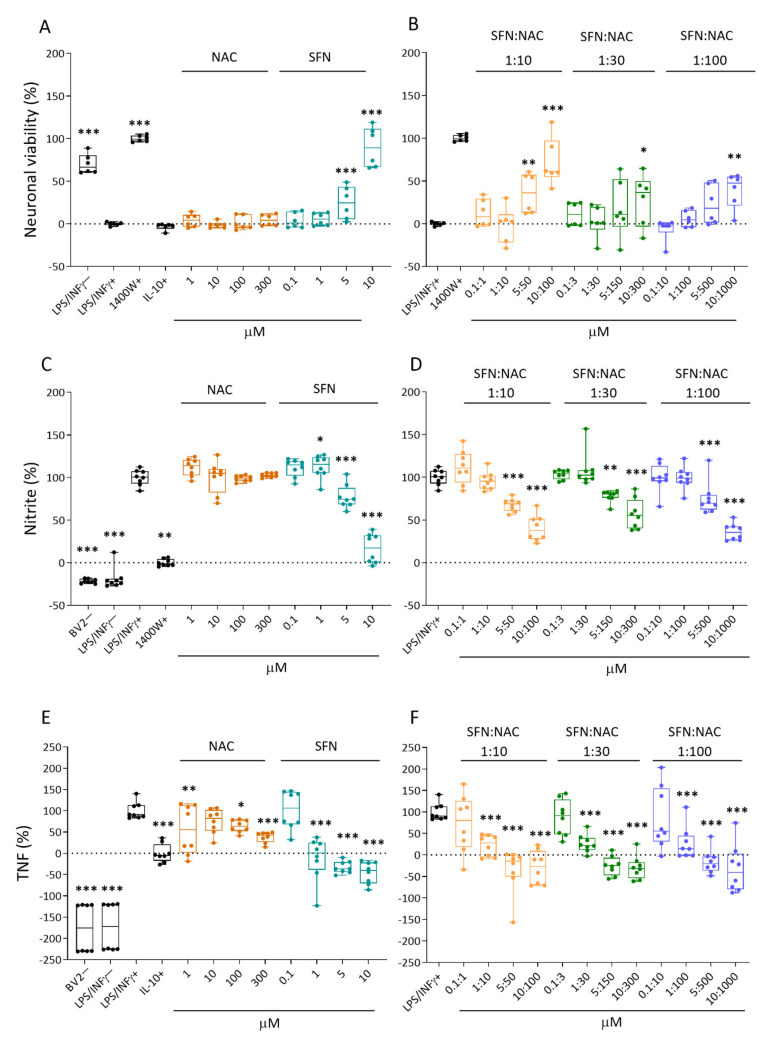Figure 2.
Effect of NAC or SFN monotherapy and SFN+NAC duotherapy on neuronal viability, and nitrite and TNF levels in cortical neuron-BV2 co-cultures in vitro. (A) Monotherapy with NAC did not affect the LPS/INFγ+ -induced cell death (p > 0.05). SFN monotherapy at 5 µM (p < 0.001) and 10 µM (p < 0.001) concentrations increased cell survival, a dose of 10 µM being almost as effective as the iNOS inhibitor 1400W (positive treatment control). Note that the anti-inflammatory cytokine IL-10 did not increase cell survival. (B) The 2 highest concentrations of 1:10 SFN+NAC duotherapy ratios (5 µM+50 µM [p < 0.001] and 10 µM+100 µM [p < 0.001]) promoted neuronal survival. The effect of the highest concentrations at ratios of 1:30 and 1:100 (10 µM+300 µM [p < 0.05]; 10 µM+1000 µM [p < 0.01]) were meager. Note that in panels A and B neuronal viability was less in those particular wells with value below 0% than on average in the LPS/INFγ+ -treated wells. Furthermore, the compound was better in those particular wells with value above 100% than the positive control. (C) Monotherapy with NAC did not affect the LPS/INFγ+ -induced increase in nitrite levels in the cell culture medium (p > 0.05 compared with LPS/INFγ+ ₋treated cultures [100%], to which the nitric oxide levels in all other samples were normalized). SFN induced a dose-dependent reduction in nitrite levels, a dose of 10 µM (p < 0.001) being almost as effective as the iNOS inhibitor 1400W (inhibitor of iNOS, positive treatment control). Note that the BV2− (no BV2 cells, only cortical neuronal cells) and LPS/INFγ− cultures were not exposed to a neuroinflammatory agent (LPS/INFγ+), and thus showed no nitrite release into the culture medium (baseline). The positive treatment control, 1400W, reduced the nitrite levels almost to the baseline level. (D) The 2 highest concentrations of each of the 3 SFN+NAC duotherapy ratios reduced the LPS/INFγ+ -induced increase in nitrite levels in a dose-dependent manner. The overall SFN+NAC duotherapy effect on nitrite levels was comparable to that of SFN monotherapy. (E) Monotherapy both with NAC and SFN reduced the LPS/INFγ+ -induced increase in TNF levels in a dose-dependent manner. The SFN monotherapy at 5 µM (p < 0.001) or 10 µM (p < 0.001) concentrations reduced the TNF levels even more than treatment with the positive control, IL-10 (TNF inhibitor). (F) All 3 SFN+NAC duotherapy ratios reduced the LPS/INFγ+ -induced increase in TNF levels in a dose-dependent manner. Note that in panels C to F nitrite and TNF levels were higher in those particular wells with value above 100% than on average in the LPS/INFγ+ -treated wells. Furthermore, the compound was better in those particular wells with value below 0% than the positive control. Abbreviations: IL-10, interleukin 10; INFγ, Interferon gamma; LPS, lipopolysaccharide; NAC, N-acetylcysteine; SFN, sulforaphane; TNF, tumor necrosis factor. Statistical significances: * p < 0.05, ** p < 0.01 and *** p < 0.001 compared to the untreated co-culture exposed to LPS/INFγ+. In A-D n = 8 experimental repeats (2 batches, 4 wells/batch) and E-F n = 6 repeats (2 batches, 3 wells/batch). Data were analyzed using linear regression models in R and presented as whisker-plots with mean.

